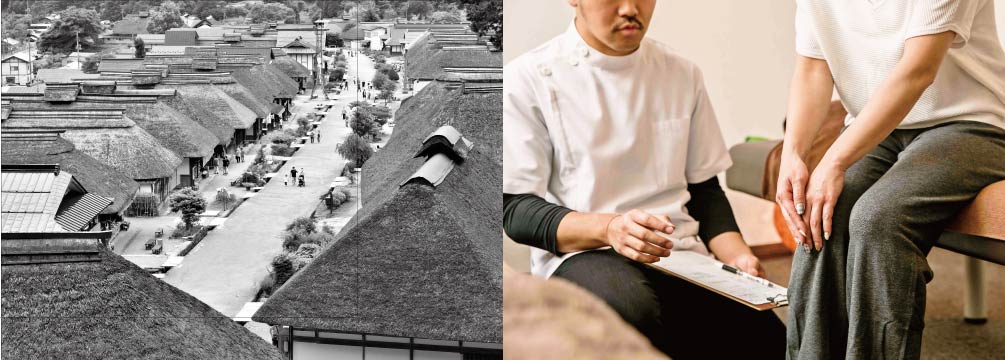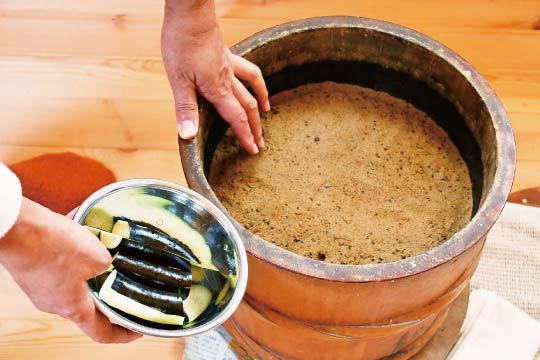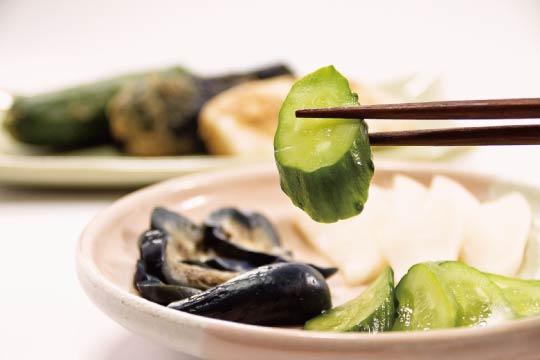News & Blogs
Nukazuke magically transforms vegetables into healthy and tasty pickles
How did fermented rice bran start and save many lives in the 17th century?
Caring for Nuka-doko during the pandemic is therapeutic
Let’s get the fermentation started
A variety of Tsukemono (pickled vegetables) for you
In this blog, we touch on diverse topics about Japanese food cultures, practices together with the culinary secret, TREHA®, and its important role in the Japanese food industry. We hope our blog helps you obtain in-depth knowledge of the secrets and science behind Japanese cuisine, shared from our kitchen, to yours.
Mixing the rice bran bed from bottom to up daily is all it takes. Nurturing a fermented rice bran bed is truly rewarding.
Fermented food items, such as yogurt, tempeh, kimchi, and Kombucha, are consumed worldwide. Japan boasts a variety of unique fermented delicacies, including miso, soy sauce, and natto (fermented soybeans). In this post, we talk about Nukazuke, fermented pickles, a traditional home-prepared condiment.
Nukazuke refers to pickled vegetables produced in the Nuka-doko (Nuka-bed), a paste consisting of rice bran, salt, and water. Not only does Nukazuke makes vegetables last longer, but it produces pickles with enhanced nutritional values and flavors. Customarily Nukazuke pickles are served as condiments for cooked rice to cleanse the palate during a meal. They are also used as filling for rice balls (onigiri) frequently.
The ingredient, rice bran, is abundant with carbohydrates and amino acids, which feed lactic acid bacteria and yeast to proliferate, amplifying the umami in the vegetables. Cucumbers, daikon radishes, and carrots are common vegetables, but any vegetables can be used.
A reinvented Nukazuke movement takes on untraditional items such as avocados, boiled eggs, and cheeses. In addition, vegetable and fruit scraps, including watermelon peels, melon peels, and broccoli stems, can be transformed into surprisingly flavorful pickles. This practice goes with the recent trend of reducing food waste by upcycling edible parts of precious food resources.

History of Nukazuke
It is believed that the forerunner of the Nukazuke, Tsukemono (pickled vegetables), appeared about 2,000 years ago as salt-cured food. The presence of Nukazuke was discovered in 1573. Although the exact period is unknown, the arrival of Nuka-bed pickles was overlapped with when the Japanese started consuming white (milled) rice instead of brown rice, which created a large amount of rice bran as a byproduct. In the 17th century, white rice caused a beriberi epidemic. Why? Believe it or not, the Japanese diet was minimal back then: one side dish, a bowl of soup, and a large bowl of brown rice, which sufficed vitamin B1 intake; thus, switching to white rice naturally invited vitamin B1 deficiency. Nukazuke, rich in vitamin B1, became a rescuer to resolve this situation and instantly spread throughout Japan.
Since then, Nukazuke has been a staple household food item. Families used to maintain their original Nuka-doko passed down from generation to generation. As time passed, many households stopped using Nuka-doko because of the daily maintenance, manually stirring the rice bran bed once a day. The necessity of this hectic routine handwork to keep the microorganisms active and potent drove people to opt for a much easier option, purchasing premade pickles. Recently, however, many decided to embrace Nukazuke again.

A new renaissance of Nukazuke during the pandemic
Why did Nukazuke regain its popularity? The pandemic created the following motives.
Fermented food items promote a healthy immune system.
Nukazuke contains 100 million cultures per gram, similar to yogurt. Besides, fermented rice bran bed contains nutrition such as vitamin B1 and potassium, in addition to vitamin E, known as an antioxidant. It is confirmed that the vitamin B complex in vegetables increases by ten folds with rice bran pickling. As health consciousness grew, Nukazuke reestablished itself as a healthy food.More time to kill at home
Nukazuke is relatively easy to make, but daily maintenance is required since the fermented bed contains live and active cultures. Although this maintenance work was the primary reason homemade pickle-making customs slipped away in Japan, people rediscovered taking care of Nuka-doko as an enjoyable activity to kill extra time. Some even named the fermented bed and took care of it as if it were their pet. As strange as it may sound, Nuka-doko would produce nutritious pickles in exchange for frequent stirring, just like a companion animal shows affection and loyalty in return for loving care. Nuka-doko blesses you with tasty pickled vegetables without requiring a living space or walking. Don’t you think it is the best pet ever?
Are you daring enough to prepare Nuka-doko to produce Nukazuke?
Ready-to-use Nukazuke paste is available at Japanese supermarkets, but a homemade bed would make the pickles taste even better. Wheat bran can substitute for rice bran, but works better with more water content.
Ingredients:
1 kg rice bran
1 liter water
120 g salt
20 g red peppers
kelp, as needed
vegetable scraps*, as needed
*Vegetable scraps provide moisture and promote fermentation as a starter. Any vegetables, including cabbage and carrots, would work.

Instructions:
Mix rice bran and salt in a bowl.
Add lukewarm water (about 40°C/104°F) and stir to dissolve the salt. Use caution for water temperature, as lactobacillus will not survive in high heat.
Place a kelp sheet on the bottom of the container and transfer the rice bran mixture. Embed vegetable scraps and red pepper deeply in the container. Pat the paste repeatedly to remove air bubbles trapped in the bed.
Mix the mixture from bottom to top daily while switching vegetable scraps every three to four days. After a few cycles of this process, the bed starts to give off a sour, miso-like scent. This means the Nuka-doko is ready. Vegetable scraps used to activate fermentation are edible but potentially too salty and lack flavors until the Nuka-doko matures. Be patient until the fermented bed comes of age.
Wash and lightly salt the vegetables before tacking them into the ready-to-use bed. The salting process may be skipped because the salt content in Nukazuke seasons the vegetables. Pickles will be ready within a day or two.
Nuka-doko maintenance:
Make sure to place Nuka-doko in the refrigerator or a cool place away from the direct sun or heat sources. More importantly, do not forget to stir the bed from bottom to up once a day.
Nuka-doko makes vegetables tasty and more nutritious. In addition, this supercharged bed with beneficial microorganisms can upcycle vegetable scraps and fruit peels. Why don’t you give it a shot and make it at home? Nuka-doko is highly recommended as a new companion animal without needing to take it for walks.
Caution: Nukazuke has a high salt content as a preserved condiment. Even though it is tasty food with health benefits, too much consumption results in excess salt intake. Please use moderation.

A variety of Tsukemono (pickled vegetables) for you
Besides Nukazuke, the Japanese consume a variety of Tsukemono (pickled vegetables) as condiments or side dishes.
Asazuke: “Asa” means light or shallow. Asazuke features a fresh and crunchy texture because of the short preparation time in the seasoning solution.
Kasuzuke: “Kasu” refers to sake lees (a creamy, paste-like byproduct of sake brewing). This pickling method can be applied to fish and vegetables featuring a hint of sweetness.
Misozuke: The versatility of miso works on fish, meat, and vegetables.
There are also pickles utilizing soy sauce (Shoyuzuke) or vinegar (Suzuke.) The list is endless. Please stay tuned for further details on Japanese pickles at another time.

Did you find this blog interesting?
Please share it with your friends in the food service industry.
We regularly update the blog about the food culture of Japan, where TREHA® was discovered for culinary applications.
Click here and send us a message to subscribe.
Or hit us up on Instagram @trehalose_sensei!

